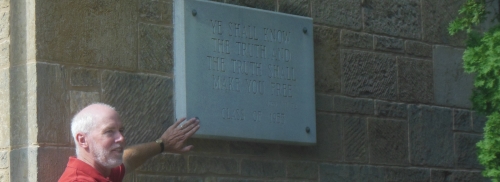
“Ye shall know the truth and the truth shall make you free,” reads the plaque quoting the gospel of John placed by the class of 1955 on the north wall of South Hall on the University of Wisconsin campus. “To the university community that’s good poetry,” said Jon Dahl, a campus staff member with InterVarsity Christian Fellowship. “We [as Christians] know that to know the truth is to know Jesus.”
Dahl, who has been in campus ministry for 26 years–20 years on the Madison UW campus, led a short guided tour from State Street up Bascom Hill following Thursday’s Upper|House presentation by Douglas Strong on “What is an Evangelical.” Dahl talked about the Christian roots of the state’s flagship campus, “to help us see where we are today and better understand on whose shoulders we stand.”
At the top of Bascom Hill, Dahl stopped in front of the Sifting and Winnowing plaque on the wall of Bascom Hall and told the story of its Christian roots. The plaque rebuffs critics of economics professor Richard Ely for his “radical” ideas. 
Ely was a founder of the Christian Social Union, which believed in applying Christian principles to the social problems of the world. It was in response to complaints made to the Board of Regents and the UW president that the landmark declaration of academic freedom was made in a report by an investigative committee.
John Bascom, for whom Bascom Hall is named, was UW president from 1874-1887. He was a seminary graduate, which was not uncommon in 19th century education. When the University of Wisconsin began in 1848, 168 years ago, four of the first six professors had divinity degrees.
Dahl said that Music Hall, with its unmistakable church design, was built as an assembly hall in 1879 to hold the student body “so Bascom could preach to them.” Chapel attendance, five days a week, was obligatory at that time.
Dahl described a meeting between Bascom and Madison pastors, who wanted a divinity school located on campus. Bascom, instead, suggested that the various denominations buy property and build student churches. That eventually led to what is today Pres House, St. Paul’s University Catholic Center, and Calvary Lutheran Chapel along the State Street Mall, and Lutheran, Methodist, and Episcopalian churches along University Avenue.
Another UW leader with a Christian background was Glenn Frank, who was president from 1925-1937. Frank was a former circuit-riding preacher who traveled with evangelist Billy Sunday in his younger days. He served as editor-in-chief of the Christian Century magazine before coming to Madison.
A century ago the premiere campus ministry was the YMCA, which was located in a four-story building between the Red Gym and where the Memorial Union now stands. The Union hadn’t been built yet and the YMCA functioned much like a union at that time. When people wanted to meet and get together, the YMCA was the place.
The YMCA as an organization no longer has a ministry focus and for years that tract next to the union has been a parking lot. Dahl cautioned ministries about losing their vision and “ending up with a hole where there used to be something vital.”
Dahl said that he intends to write up his research and make it more widely available so that students and the Madison community will have a better appreciation of the UW’s Christian heritage.
In the weeks ahead we plan to publish further reports on the vitality of the Christian community of Madison’s earlier years, such as the Sunday School conventions that drew large crowds to Olin Park.

